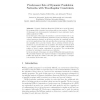Free Online Productivity Tools
i2Speak
i2Symbol
i2OCR
iTex2Img
iWeb2Print
iWeb2Shot
i2Type
iPdf2Split
iPdf2Merge
i2Bopomofo
i2Arabic
i2Style
i2Image
i2PDF
iLatex2Rtf
Sci2ools
101
click to vote
CAV
2009
Springer
2009
Springer
Predecessor Sets of Dynamic Pushdown Networks with Tree-Regular Constraints
Abstract. Dynamic Pushdown Networks (DPNs) are a model for parallel programs with (recursive) procedures and process creation. The goal of this paper is to develop generic techniques for more expressive reachability analysis of DPNs. In the first part of the paper we introduce a new tree-based view on executions. Traditional interleaving semantics model executions by totally ordered sequences. Instead, we model an execution by a partially ordered set of rule applications, that only specifies the per-process ordering and the causality due to process creation, but no ordering between rule applications on processes that run in parallel. Tree-based executions allow us to compute predecessor sets of regular sets of DPN configurations relative to (tree-) regular constraints on executions. The corresponding problem for interleaved executions is not effective. In the second part of the paper, we extend DPNs with (well-nested) locks. We generalize Kahlon and Gupta's technique of acquisitio...
CAV 2009 | Formal Methods | Interleaved Executions | Semantics Model Executions | Tree-based Executions |
| Added | 25 Nov 2009 |
| Updated | 25 Nov 2009 |
| Type | Conference |
| Year | 2009 |
| Where | CAV |
| Authors | Alexander Wenner, Markus Müller-Olm, Peter Lammich |
Comments (0)

